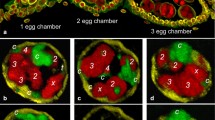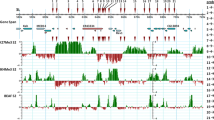Abstract
When the fourth chromosome of Drosophila melanogaster is attached, as the result of an induced translocation, to 21A in 2L or 60E in 2R, its tip exhibits a marked capacity to pair end-to-end with the tips of the other chromosomes. In each of the translocations, about 59 per cent of the contacts involving the tip of 4 were with the tip of X. If this pairing preference reflects structural similarity, the tip of 4 is much more like the tip of X than that of any other chromosome. The significance of this phenomenon is discussed with respect to the standard pattern of end-to-end association in the Oregon-R wild-type stock that provided the control preparations. In the 4-2L rearrangement, the interaction of chromosome 4 with the tip of 2L (101E with 21A) led to pronounced puffing in subdivisions 21A and B, as was most strikingly manifested when the distal segments of 2L failed to synapse and the homologue of paternal origin showed a large puff whereas that of maternal origin (not carrying the fourth chromosome) remained unpuffed.
Similar content being viewed by others
Literature
Bauer, H.: Structure and arrangement of salivary gland chromosomes in Drosophila species. Proc. nat. Acad. Sci. (Wash.) 22, 216–222 (1936).
Berendes, H. D., and G. F. Meyer: A specific chromosome element, the telomere of Drosophila polytene chromosomes. Chromosoma (Berl.) 25, 184–197 (1968).
Bridges, C. B.: Current methods for permanent aceto-carmine smears. Drosophila Inform. Serv. 6, 31–35 (1936).
Gay, Helen: Chromosome structure and function. Carnegie Inst. Wash. Year Book 62, 503–510 (1963).
Gershenson, S.: The nature of the so-called genetically inert parts of chromosomes. Vid. Akad. Nauk U.R.R.S. 3, 116 (Ukrainian with English summary), (1940).
Grell, Rhoda F.: Pairing at the chromosome level. J. cell. Physiol. 70, Suppl. 1, 119–145 (1967).
—, and E. H. Grell: The behavior of nonhomologous chromosomal elements involved in nonrandom assortment in Drosophila melanogaster. Proc. nat. Acad. Sci. (Wash.) 46, 51–57 (1960).
Hinton, T.: A study of chromosome ends in salivary gland nuclei of Drosophila. Biol. Bull. 88, 144–165 (1945).
—, and K. C. Atwood: Terminal adhesions of salivary gland chromosomes in Drosophila. Proc. nat. Acad. Sci. (Wash.) 27, 491–496 (1941).
—, and A. H. Sparrow: The non-random occurrence of terminal adhesion in salivary chromosomes of Drosophila (Ahstract). Genetics 26, 155 (1941).
Kaufmann, B. P., and M. K. Iddles: Ectopic pairing in salivary-gland chromosomes of Drosophila melanogaster. Port. Acta biol. A 7, 225–248 (1965).
Lindsley, D. L., and E. H. Grell: Genetic variations of Drosophila melanogaster. Carnegie Inst. Wash. Publ. No. 627 (1967).
—, and E. Novitski: Frequent linkage of YSX.YL and chromosome 4. Drosophila Inform. Serv. 27, 99 (1953).
Parker, D. R.: Radiation induced exchanges in Drosophila females. Proc. nat. Acad. Sci. (Wash.) 40, 795–800 (1954).
Perreault, W. J., H. Gay, and B. P. Kaufmann: Base composition of DNA in heterochromatin of Drosophila melanogaster. Drosophila Inform. Serv. 41, 80 (1966).
—, B. P. Kaufmann, and H. Gay: Similarity in base composition of heterochromatic and euchromatic DNA in Drosophila melanogaster. Genetics 60, 289–301 (1968).
Prokofyeva-Belgovskaya, A. A.: Inert regions in the distal ends of chromosomes of Drosophila melanogaster. Bull. Acad. Sci. U.R.S.S. (ser. Biol.) 3, 719–724 (1937).
Sandler, L., and E. Novitski: Evidence for genetic homology between chromosomes I and IV in Drosophila melanogaster, with a proposed explanation for the crowding effect in triploids. Genetics 41, 189–193 (1956).
Stone, W. S., and A. B. Griffen: Changing the structure of the genome in Drosophila melanogaster. Univ. Texas Publ. 4032, 208–217 (1940).
Author information
Authors and Affiliations
Additional information
This study was supported in part by a Research Grant (GM-10499) from the National Institutes of Health, U.S. Public Health Service.
Rights and permissions
About this article
Cite this article
Kaufmann, B.P., Gay, H. The capacity of the fourth chromosome of Drosophila melanogaster to establish end-to-end contacts with the other chromosomes in salivary-gland cells. Chromosoma 26, 395–409 (1969). https://doi.org/10.1007/BF00326352
Received:
Issue Date:
DOI: https://doi.org/10.1007/BF00326352




